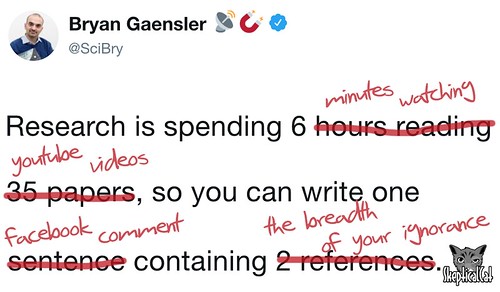Being a science teacher is not just about teaching dry boring facts. Actually we don’t teach facts at all we talk about evidence and theories. A big part about science is critical thinking. It is our job to teach our students how to think critically about everything they encounter. The first 25 pages of the Science curriculum discusses students thinking critically and using inquiry. Digital literacy and misinformation is a perfect way to teach these valuable skills.
Teaching students to critically think about science and misinformation go hand in hand. When teaching students to be skeptical of a study a big thing we say is does this make sense? Is what the author is saying here make sense with what you know? If the answer is no then you should be skeptical. The key thing here is not dismissive but skeptical.

The first thing you should do is look at the journal the article is published in. You should do the same thing for News reports as explained in Techniques in Teaching and Learning. If the article is coming from an obscure news source or scientific journal then most likely it is at least partially misleading.
Another important piece of the puzzle is being skeptical of things we agree with. It’s a lot easier for me to call something a fact or truth if it falls in line with my beliefs. The Pew study where they asked Americans to identify statements as factual or opinion is eye opening.

Photo Credit: marcoverch Flickr via Compfightcc
As NPR says most Americans only did slightly better than random chance at identifying statements. This is why it is important to be teaching our students to think critically. To not just go with our gut but to look at things with a discerning eye.
So how do we actually teach students to think critically about misinformation online? Well Edcan has a great article here but I’ll summarize the points that I think are important (my opinion not a fact).
Prioritize helping students develop investigative techniques: this means teaching them to reverse image search in Google. Gizmodo has a great running series debunking fake viral photos and posts. Their main weapon is usually just a reverse Google image search to turn up the original photos.

Photo Credit: wuestenigel Flickr via Compfightcc
Teach students to identify bias: it is important for students to understand that bias is inherent in all humans. A lot of them will probably be familiar with the idea that Fox News is biased however showing them that all journalism is biased can be a wake up call. Every day journalists and news organizations need to decide what to include in the news and what they choose to include or not is shaped by conscious or unconscious bias. This can also be used within science because scientists are people too. They have their own biases and though lots of people like to think that science is pure it is not. Teaching students that scientists have bias is another way to get them to think critically about the world at large.
Bring real-world fake news examples that we encounter everyday into the classroom: Using news in the classroom is important in so many ways. Science articles are a perfect example of this

A lot of times News Articles about science and medicine overstate the results or conflate small scale trials or studies to being true for everyone. Teaching students to not just trust the article and to actually go to and read the source is an important skill.
Misinformation has become an endemic issue in our society. Teaching students to stop and think critically about things they read, hear and see is an important skill for the rest of their lives. Not only will they be more informed but they won’t get caught giving money to the latest Prince of Nigeria.

I enjoyed your post Corey. The tweet stating people spend 6 minutes watching a video and then offer advice is bang on. Thinking critically is a skill that goes beyond just deciphering fake news. Great post!
LikeLiked by 1 person
Great post Cory!
I agree with the image at the top of the post that stated people spend 6 minutes reading and then make an uninformed comment I think that is one of the problems with everyone having a platform and being able to say anything that comes to there mind.
Critically thinking students are not just important for pointing out fake news. critically thinking students turn into critically thinking adults and that is good for all of society.
LikeLike